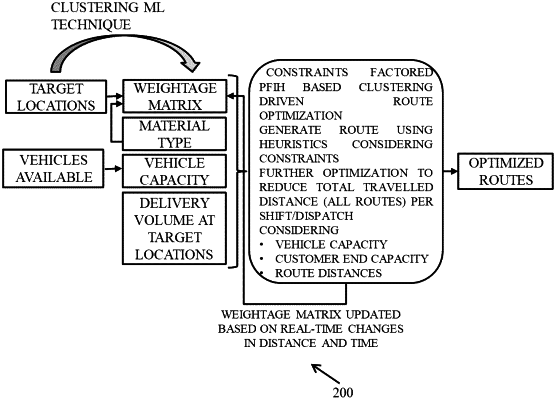| CPC G01C 21/3415 (2013.01) [G01C 21/20 (2013.01); G06Q 50/30 (2013.01)] | 11 Claims |

|
1. A processor-implemented method for fleet route optimization comprising:
splitting, via one or more hardware processors, a target location data associated with a geographical area comprising a plurality of target locations into a plurality of clusters based on a distance constraint and a material constraint using a clustering technique, wherein each cluster comprises predefined number of target locations;
computing a weightage matrix via the one or more hardware processors, wherein elements of the weightage matrix comprises relative weights between a source location and the plurality of target locations in the geographical area, wherein the elements of the weightage matrix are derived based on a weight assigned to each target location as a function of distance and time between the source location and said target location, and a penalty value associated with the target location in case of delay, wherein the weight matrix is dynamically updated for each planning instance based on historical data and previous instance data, wherein the previous instance data is a previous day's instance or a previous trip's instance taken on a same day; and
creating, via the one or more hardware processors, optimized routes for the plurality of clusters, wherein the creation of optimized routes are enabled by monitoring through an application and dynamically change or alter the routes based on new order or execution challenges, wherein creating an optimized route for a cluster from amongst the plurality of clusters comprises:
obtaining a set of initial routes by applying, for each cluster of the plurality of clusters, a heuristic model using the weightage matrix and a set of constraints associated with a set of vehicles, the set of constraints comprising a set of vehicle capacity constraints, a set of location constraints associated with the source location and target location, the distance constraint, and vehicle driver constraints;
optimizing the set of initial routes based on a minimization of at least one of the distance constraint, a time constraint and the set of vehicle capacity constraints to obtain a set of final routes;
obtaining a real-time data associated with distance and time based on the set of initial routes followed by the vehicles in real-time, the real-time data comprising the distance and the time associated with the source location and the target locations;
updating the weightage matrix based on the real-time data; and
optimizing the set of final routes based on the updated weightage matrix to obtain the optimized route, wherein the fleet route optimization employs heuristics and the clustering technique tuned for reduced computational response times considering capacity and route distances to arrive at the optimized route.
|